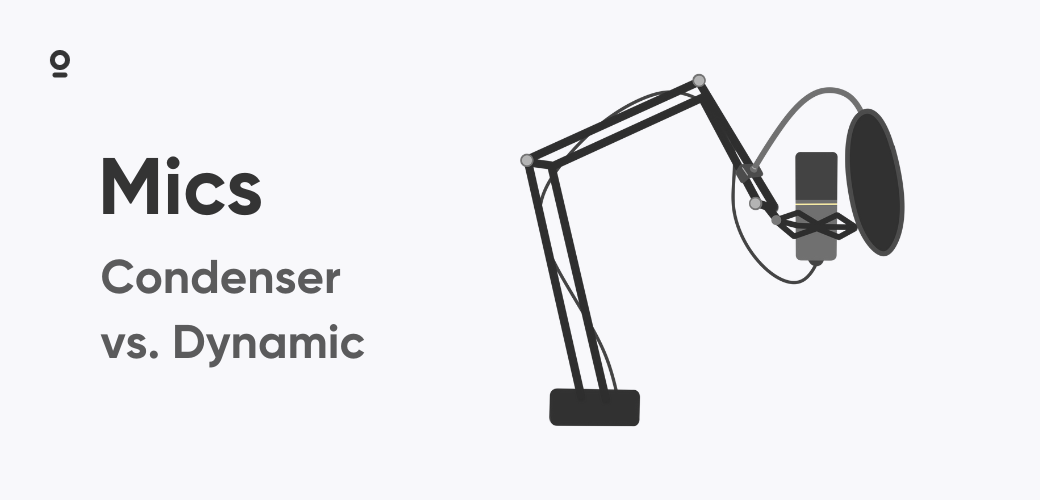Every successful podcast begins with a clean, intelligible signal. Podcasters weighing the condenser mic vs dynamic mic debate must consider sensitivity, room acoustics, durability, and power requirements before hitting record. Though the two designs look similar on a boom arm, they behave very differently once the red light turns on. This guide unpacks how each capsule works, where it shines, and how to choose the mic that keeps editing simple and livestreams sounding professional.
Technology in Plain Language
Dynamic microphones convert movement in a magnetic field into voltage. A thin diaphragm bonds to a voice coil; when the diaphragm vibrates, the coil moves within the magnet and generates current. Few fragile parts mean dynamic mics shrug off heat, humidity, and the occasional whack from an enthusiastic co-host.
Condenser microphones operate on variable capacitance. A lightweight diaphragm sits a hair's breadth from a charged backplate. Minute changes in that gap create tiny voltage fluctuations, which an internal preamp magnifies. Phantom power---usually +48 V---keeps the circuit alive. The trade-off: greater detail but a need for gentler handling and clean power.
Sensitivity, Distance, and Background Noise
Capsule sensitivity dictates how close a host should sit to the mic and how loudly the preamp must work. Dynamics are purposely low in sensitivity, so the mouth stays five to fifteen centimetres from the grille. Close-talking boosts warmth through the proximity effect and leaves keyboard clicks or HVAC rumble well behind the voice in the mix.
Condenser capsules run hotter. They sound natural ten to twenty centimetres from the source and capture every breath nuance, lip smack, and subtle laugh. In a treated booth, that intimacy sounds crisp; in an untreated spare room, the same sensitivity highlights reflections and computer fans. RØDE's streaming tests confirm these distance ranges.
Maximum Loudness and Headroom
Dynamic capsules tolerate extreme sound-pressure levels before clipping. Snare drums, brass sections, and cranked guitar cabinets can push past 140 dB SPL, and a dynamic microphone sails through without folding. Condensers emphasise nuance over brute force and can distort sooner, though many models include -10 dB pads for safety. Most talk-centric shows sit well below those limits, but sudden shouts or applause still favour the dynamic's headroom.
Use-Case Snapshot for Podcasters
Intimate studio shows and narrative storytelling
Large-diaphragm condensers dominate vocal booths because they reveal subtle inflections, airy overtones, and room tone---critical for narrative podcasts and audiobook-style productions. Related searches for dynamic vs condenser for vocals often highlight this clarity advantage.
Round-table debates, live events, and on-the-go interviews
Sweetwater's engineers recommend dynamics for loud stages and crowded venues. Lower sensitivity rejects spill, and road-tough housings survive transit. If the show moves from cafés to conferences, dynamics keep distortion and handling noise in check.
Gaming, streaming, and hybrid video podcasts
RØDE's streaming research shows a tight-pattern dynamic such as the XDM-100 excels next to mechanical keyboards and GPU fans---making it the best mic for noisy room scenarios. In well-treated studios, a condenser like the XCM-50 adds polish and sparkle; in untreated spaces, the dynamic's rejection keeps distractions out of the mix.
Room Treatment, Polar Patterns, and Common Myths
A frequent forum myth suggests dynamics inherently "pick up less background noise." Distance, not capsule type, is the real lever. Any mic planted five centimetres from the host's mouth will produce a higher voice-to-room ratio than one hovering twenty centimetres away. Condensers aren't noisier by design; they're simply used farther away in many setups.
Polar pattern matters, too. Handheld dynamics are typically cardioid or super-cardioid, focusing on the front and rejecting the rear---helpful when best mic for streaming searches emphasise noise control. Many condensers add omni or figure-eight options, great for two-person narration or room ambience but risky in reflective spaces. If wall treatment is minimal, cardioid remains the safest bet.
Advantages and Limitations
Dynamic advantages
- Handles extreme SPL without distortion---ideal for live panels and energetic guests.
- Requires no phantom power, simplifying mobile rigs and entry-level interfaces.
- Rugged shells and simple internals tolerate frequent travel.
Dynamic trade-offs
- Lower output may need a clean-boost preamp.
- Mostly fixed polar patterns limit flexibility for multi-voice sessions.
Condenser advantages
- Extended frequency response and fast transient capture reveal fine details.
- Higher native output lowers noise on budget interfaces.
- Many models include pads, filters, and switchable patterns for advanced control.
Condenser trade-offs
- Needs phantom power and careful handling.
- High sensitivity amplifies reflections in untreated rooms.
- Humidity or temperature swings can shorten capsule lifespan.
In short, the difference between dynamic and condenser microphones boils down to sensitivity, durability, and power demands.
Five-Step Decision Checklist for Podcast Hosts
- Audit the room: If a loud clap produces noticeable echoes, a close-talked dynamic buys time until acoustic panels arrive.
- Gauge source volume: High-energy comedy or on-the-street reporting leans dynamic; whispered storytelling benefits from condenser nuance.
- Confirm interface specs: Interfaces with phantom power and 55 dB of clean gain support both mic types. No phantom power? Start dynamic.
- Factor in portability: Podcasters who travel or share gear appreciate a dynamic mic's resilience.
- Plan for remote guests: Zencastr records each participant locally, so even an affordable handheld dynamic captures pristine 48 kHz WAV tracks.
Frequently Asked Questions
Do dynamic microphones need phantom power? No. Dynamic circuits generate voltage passively and work without external power.
Will a condenser microphone capture keyboard clicks? Yes, if placed too far from the speaker or used in a reflective room. Reducing distance, engaging a noise gate, adding isolation panels, or opting for a dynamic capsule minimises peripheral noise.
Can a dynamic microphone produce studio-quality vocals? Absolutely. Broadcast staples like the Shure SM7B and Electro-Voice RE20 are dynamic designs trusted on countless interview and news shows.
Conclusion
Choosing between a condenser mic vs dynamic mic hinges on environment, content style, and workflow. A condenser rewards treated studios with lifelike highs and nuanced transients, while a dynamic keeps focus on the source in noisy or unpredictable spaces. Capture every episode at its best---start a 14-day free trial of Zencastr and hear how the right mic and the right platform elevate your podcast.







